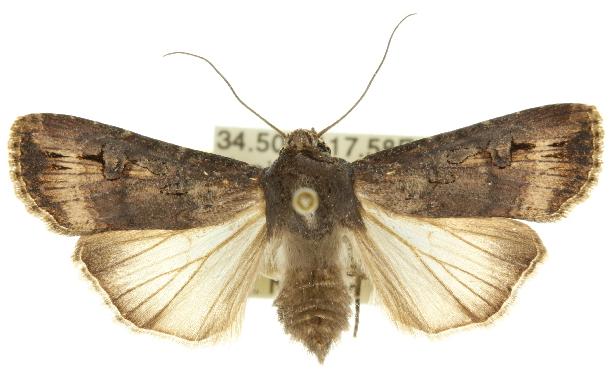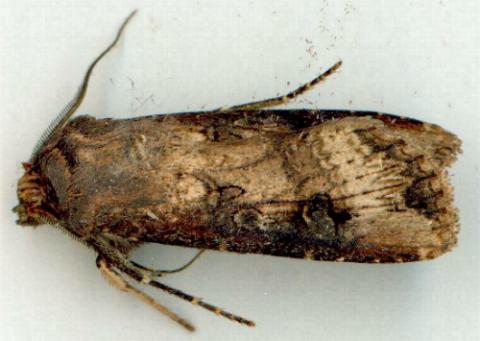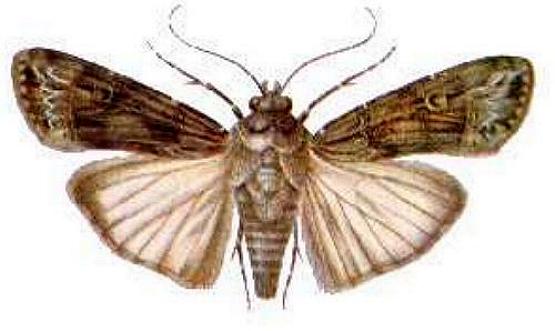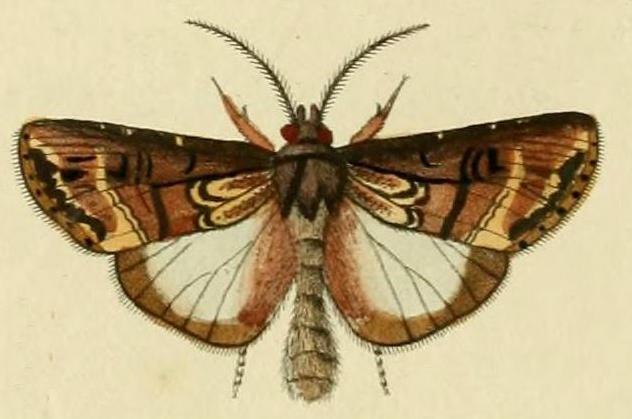
| Black Cutworm (one synonym is Noctua idonea Cramer, 1780) NOCTUINAE, NOCTUIDAE, NOCTUOIDEA | (donherbisonevans@yahoo.com) and Stella Crossley |

(Photo: courtesy of
Institut National de la Recherche Agronomique, France)

| Black Cutworm (one synonym is Noctua idonea Cramer, 1780) NOCTUINAE, NOCTUIDAE, NOCTUOIDEA | (donherbisonevans@yahoo.com) and Stella Crossley |

(Photo: courtesy of
Institut National de la Recherche Agronomique, France)
The scientific name of this species reflects the marking on the forewing of the adult moth which resembles the Greek character Ipsilon.
The Caterpillar is pale brown with a number of darker lines along the body. The caterpillar is worldwide pest, attacking leaves, stems, and roots of many agricultural crops, including :

The adult moth has brown forewings and a dumb-bell mark in the centre of each wing, like other species in the Agrotis genus, but specifically has a paler area around the tips of the forewings. The hind wings are buff, darkening to the margin, with dark veins. The moth has a wingspan of about 4 cms. The pheromones of this species have been identified.

One female adult moth can lay over 1,000 eggs. They are laid in clutches of a dozen or so on leaves of plants in damp areas. The eggs hatch in about 5 days.

The species has migratory habits. and occurs world-wide, for example:
and the subspecies aneituma occurs in Australia in:
although it is endemic only in the warmer half of the continent.

Possible control measures, depending on the crop, include :

Further reading :
David Carter,
Butterflies and Moths,
Collins Eyewitness Handbooks, Sydney 1992, p. 252.
Ian F.B. Common,
Moths of Australia,
Melbourne University Press, 1990, fig. 50.4, pp. 55, 64, 467.
Pieter Cramer,
Uitlandsche kapellen voorkomende in de drie waereld-deelen,
Amsterdam Baalde, Volume 3 (1780), p. 150, Fig. H, and also
Plate 275, fig. H..
Johann Siegfried Hufnagel,
Forsetzung der Tabelle von den Nachtvögeln: IV,
Berlinisches Magazin,
Volume 3, Part 4 (1766), p. 416, No. 99.
Peter Marriott & Marilyn Hewish,
Moths of Victoria - Part 9,
Cutworms and Allies - NOCTUOIDEA (C),
Entomological Society of Victoria, 2020, pp. 30-31.
 caterpillar |  butterflies |  Lepidoptera |  moths |  caterpillar |
(updated 15 April 2013, 20 November 2025)